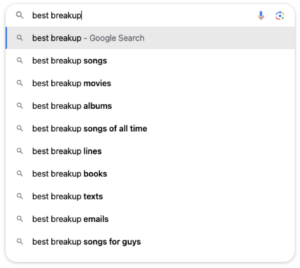Make Parting Such Sweet Sorrow: Best Sales Breakup Emails
Have you ever read about how to write a sales breakup email?
Someone in the RevGenius community asked how to write a great breakup email, which made me curious about what’s out there.
I have written many breakup emails in my time, but I when went to find inspiration on the subject—there was little to see.

It makes sense: Most salespeople are not interested in breaking up with a prospect.
When only about 60% of reps make quota, walking away from people with a pulse and budget is not ideal. But in sales, shi… things happen.
Surprises turn up. Prospects waffle. Showstoppers emerge.
It’s good to create clarity for where things stand. And sometimes, it’s appropriate to end the opportunity—or at least make it seem like you think it already is to draw your prospect back in.
Most guides on breakup emails—like this one and this one—make the sales lead sound whiney and desperate. They remind the prospect that they’re ignoring you and implicitly give them your blessing to keep doing so.
Here are four better ways to get your counterpart to engage—while leaving them feeling in control and respecting you as a partner.
Cutting Through the Crowd
Sometimes, you’re in a crowded space, and you need to grab your prospect’s attention by appealing to their better angles—and poking their FOMO into overdrive.
Let me show you a great breakup email we once used to cut through the noise and leave our prospect wanting us and only us.
For context, once, a prospect asked us—to our surprise—to participate in a competitive RFP process.
In the year prior, we had built relationships with several decision-makers on the team, and we felt good about our company’s standing with theirs.
Then, suddenly, they released an RFP for the product and service we offered. We had no idea this work would go to bid, as it was not required to go to bid.
Nevertheless, it did, and our counterparts did request that we submit a proposal.
We read the bid requirements, and something felt off. It seemed like they wrote the RFP for a specific bidder—and it was clear to us that we weren’t that bidder.
We went back and forth on whether to submit a proposal for a few days.
On the one hand, we wanted the work. This work would give us a marque client and a significant source of revenue.
On the other hand, we didn’t want to walk into a process wired for someone else and be on record as losing a bid to our most visible competitors.
After all our deliberations, we decided to decline our client’s request, but we didn’t just say “no thanks” and take our ball and go home.
We crafted the perfect breakup email, knowing it would either end the opportunity because we weren’t the right partner or draw them back to the table.
[Client first name] and team,
We appreciate your invitation to bid for this critical work. After much consideration, we respectfully decline to submit a response for this RFP process.
We understand your team is on a mission to radically reimagine how your industry delivers value to customers. We believed you wanted a collaborative partner to pioneer that path with you—to push the boundaries of what’s currently possible.
As we read the requirements of the bid, it seems you have a specific vendor in mind and are seeking more of a transactional vendor than the transformational partner we aim to be with you.
Our mission is to elevate the best in the industry to new heights of innovation and impact. Should that mirror your path, we’d love to continue the conversation.
And if not, we respect the effort you’re putting in the direction you’re going, and we wish you great success in the path ahead.
Sincerely, [signed by the lead sales rep]
Why does this email work?
There are two possible scenarios when sending this email: Either you’re “wrong,” and they do want to partner with you, or you’re “right,” and they don’t.
- If you’re wrong, you will trigger their bias to correct your understanding of the situation. It’ll be a “whoa, whoa, whoa” moment.

Your message will likely result in an immediate response and a meeting to clarify the current state and how to move forward.
When we sent this email, we captivated their attention and eventually moved the process from competitive bid to sole source procurement.
- If you’re “right,” you empower your customer to take a graceful out from working with you.
Ending the pursuit this way positions your team as one who honors and respects your prospect. They feel like they are in charge and that you operate in their best interests. And sending the message from the lead sales rep shows you’re not playing power games and trying to shame or intimidate them.
So, while this opportunity may be over, treating a prospect this way keeps the door open for future opportunities and continued engagement going forward.
Compelling Them to Reengage
How many times have you had several rounds of back and forth with a prospect, only to have them blow you off and ignore you when it’s time for them to make a decision?
It’s the worst.
It leaves you asking, “Was it me? Was it something I did or said? Or something I didn’t do or didn’t say?”

It’s possible, but I would bet good money that nothing substantive has changed. It’s much more likely your prospect got busy, overwhelmed, or distracted.
That’s why this next breakup email is so effective—it grabs your prospect’s attention and puts you top of mind without aggressive tactics, nagging, or judgment.
Here’s how I do it:
- Two (or so) days after your last message, reply to that message to bring it back to the top of the inbox with a simple message like,
“Hi, [client name] — could we follow up on this message in the next [reasonable time frame]?”
- Then, for whatever time frame you used, wait that long and then another day or so to send the breakup email.
- Don’t rush it—you don’t want the prospect to feel time-pressured by the message. You want them to feel overdue to respond when they see it. Send them a single-line question in your email that assumes they want to end the conversation, such as:
“Should I assume that we are no longer moving forward with this engagement?”
Or,
“Have you decided this initiative is no longer a priority?”
Or,
“Should I assume you’ve found a better partner for this work?”
Etc.
Do not start this message with “Hello” or use their name. You did that in your last message, which is probably readily visible on the screen.
Do not remind them you said you would check in. They already know that, and they may have even agreed to it.
Your one-line message should feel direct and firm but not judgmental.
Why does this email work?
The structure and tone of this message trigger three things:
- First, people hate feeling misunderstood. If you’re assuming something incorrectly, they will want to set the record straight. They will feel compelled to correct you.
“No, no, no—we still need this work. Can we meet tomorrow at 1 pm?”
- Second, it puts them in the driver’s seat and gives them an out. What you’re suggesting—that they don’t want to work with you—may indeed be true, and since you’re “already assuming it,” there’s significantly less embarrassment in admitting it.
“Hi, [sales rep name]. I’m so sorry for the lack of response. There was a sudden leadership change on my side, and now everything is up in the air. I don’t think we’ll be moving forward. I wasn’t sure how or when to tell you—I appreciate that you reached out. It’s been a pleasure working with you.”
- Lastly, this message reminds them you’re a partner and an equal, not a servant. This note shows you’re willing to move on. It doesn’t scream that you want to move on, but it shows you’re not desperate. You show that you’re in charge of yourself, and if moving on is the right thing to do, then that’s what you’ll do.
“Not at all! I routed your last proposal through legal and finance, and we’re about ready for final signatures. Let’s meet later today if you have time.”
If your prospect ignores you, they probably already feel they “owe you” a response. This simple message prompts them to do that in a direct, respectful, and empowering way.
Letting Them Go—It’s Them
Sometimes, you get involved with a prospect and later learn they are not someone you want to do business with.
Maybe they’re unreasonable. Or disrespectful. Or abusive. Or they aren’t your Ideal Customer.
No matter what it is, sometimes the right thing to do is walk away.

But the difference between building your brand and destroying it can come with how you walk away.
I’ve written breakup emails to clients like these in the past. They are always gut-wrenching because no one wants to receive—or give—unfavorable news.
But the longer you go between knowing you need to end the relationship and sending this email, the harder it will be.
Before the example, it’s essential to keep these two guiding principles in mind:
- First, unless the prospect is abusive, this email should never be the only form of communication. You should talk directly after giving the news.
- Second, this email should never be a surprise. A reasonable person should see it coming.
With those two things in mind, here’s how I’ve approached this email:
- First, I send the email. Then, separately—and immediately after sending it—I set up a meeting for the same or the next day.
- The client might need to adjust the time, but I’m proactive about setting a time to show I want to have this conversation and think it’s important.
My email reads like this:
[Name], we have decided to stop pursuing this work.
We set up a meeting at [date and time] to discuss our decision further. We understand if you prefer not to meet, and there would be no hard feelings for that decision. If the time we proposed does not work, please let us know what does.
As we close our collaboration, we’d gladly refer a couple of companies we know and trust who we think would do great work with you. Please let us know. We can discuss this during our meeting later.
[Lead sales rep name]
Then, use the follow-up meeting to give a human voice to the message in the email.
This meeting is not a negotiation. It reinforces the decision and sets a plan to bring the process to a close, should the pursuit require one.
Why does this email work?
Maybe the more important question is, why not call first?
There are good reasons to call first, but sending the email first serves two purposes:
- First, documentation. This note is an official notice of a decision that leaves no ambiguity as to your intentions or the time and manner in which it happened.
- And second, it gives your prospect time and space should they have an emotional reaction rather than a measured response.
One might argue that an email over a call shows you’re unwilling to share this news directly. However, sending the meeting invite immediately after the email demonstrates you are not trying to avoid the tough conversation.
So now, why does this email work?
- First, the message is simple and direct. It conveys what they need to hear in unambiguous terms.
It’s like Brad Pitt said in the movie Moneyball, “They’re professionals. Be straight with them. No fluff, just facts.”

- Second, it doesn’t arm them with details to argue. Once you’ve made the decision, there’s little use needling in a thousand points on why.
Again, the prospect should not be completely surprised by this message—if they are, you probably owed them more feedback leading up to that.
- Third, it asserts your place as an equal partner.
Offering a product or service to a prospect does not make you subservient to them. This approach reinforces that you have agency over how you operate and with whom you work.
Use this email to cut ties with prospects who will make miserable customers and thank yourself later.
Letting Them Go—It’s Me
Not every prospect you let go is one you want to walk away from.
Sometimes, you want to break up with a prospect not because they are a pain to work with but because irreconcilable logistical issues emerge that you can’t get past.
Maybe implementation requirements (assigning resources, timing, etc.) aren’t quite aligned.
Or the buyer can’t get their IT or security team on board.
Or they won’t give you the data rights you need.
Whatever the scenario, you don’t want to end the opportunity, but you know it won’t lead to an engagement that will create a good experience for your customer or your business.

It’s critical in this moment to lead with kindness and respect.
Remember, every touch point you have with a prospect—especially prospects that don’t convert—adds a brushstroke to the tapestry that is your brand.
Avoid harsh marks by giving prospects an out without creating nightmares for you.
Hi, [client name].
After much deliberation, we’ve unfortunately decided we cannot move forward with our collaboration.
Our understanding of resource prioritization of this work means we would not start our engagement for at least 6-9 months. Our current capacity planning makes it difficult to guarantee that we will have capacity available then, and as such, cannot agree to an engagement under those terms in good faith.
Should your priorities shift and capacity become available within the next quarter, we’d love to renew the conversation.
Sincerely, [lead sales rep]
An email like this lets the prospect know you do want to work together, and you believe the work together could be successful, but that you are unable to overcome a specific issue that would hurt both you and them. It’s the perfect way to put the people above the issue in a conflict.
What Makes Breakup Emails Work
No matter if you’re secretly hoping to move the relationship and opportunity forward or formally ending it, a great breakup email creates clarity on where things stand.
Most sales reps are great at starting relationships, but fewer excel at acknowledging when a relationship should end.
If you want to master the breakup email as a tool to ‘define the relationship’ with your prospects, remember these three guiding principles:
Never lie.
Sincerity and authenticity are key to productive, tough conversations—and lasting relationships. If you minimize concerns or exaggerate your admiration for your prospect, you’ll have to carry that forward as long as the relationship lasts—and the truth always comes out eventually.
Don’t be rude or mean-spirited—be honest, measured, and respectful.
Try to leave them in a better spot.
Breaking up is never fun. Feeling like you’re second best is not something you celebrate.
But those that win are great at playing the long game. Showing a prospect that you still care even after you know you’re not moving forward shows you are committed to a longer relationship with them.
Don’t give your products away for free, but offer them simple things with outsized impact at little cost to you.
Offer them your perspective on blind spots they have that you uncovered during discovery. Recommend frameworks or books that would help their work. Alert them to headwinds ahead.
Whatever it is, give them these pieces of value that put them in a better place without undercutting the value of your offerings.
Ask if you can keep the lines of communication open.
Saying “no” for now does not mean “no” forever, but getting to “yes” in the future is not a given either.
As appropriate, use your breakup emails and follow-up conversations to find proper ways to continue building your relationship with the prospect and helping them succeed.
Most people remember those who are kind to them, care about their future, and help them win. If you can leverage your breakup emails into an opportunity to build an enduring relationship with your prospect, you will undoubtedly be top of mind for opportunities as their needs evolve.
And who knows, you might even gain an incredible professional friend along the way.
